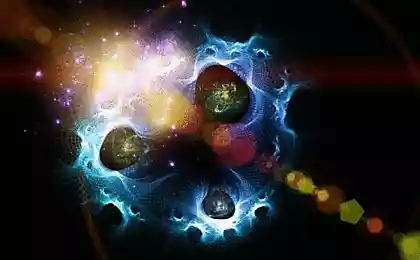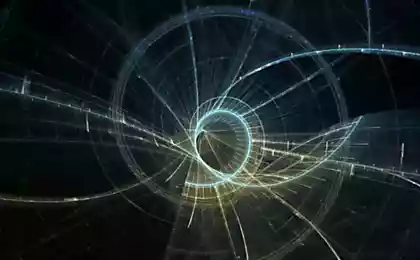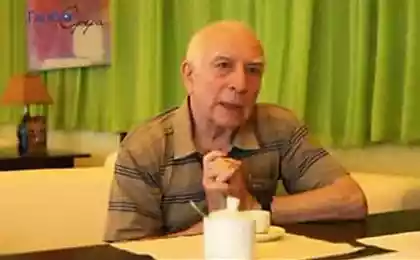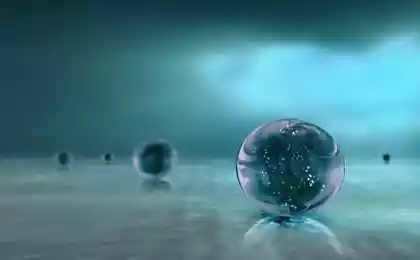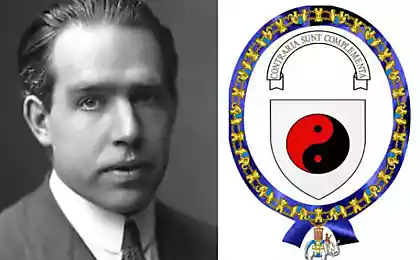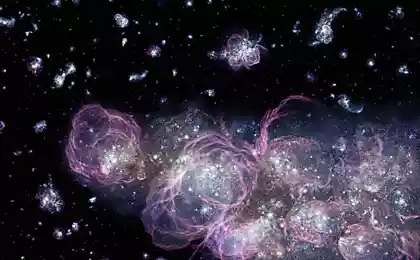638
Weird energy: introductory course in physics in the spirit of Lewis Carroll
In 1995, physicist Robert Gilmore, Professor at Bristol University, wrote a charming an educational program on quantum mechanics — based kerollovskaya "Alice in Wonderland". In it Alice meets with the photons, learns from mermaids on the theory of the multiverse, and watching the antimatter.
Published several excerpts from the book about how the probability distribution and why the energy is like money.

Non-random house
...She went to an empty spot near the road where a group of construction workers gathered near a pile of bricks. Alice assumed it was the builders as they unloaded new bricks from a small truck.
"At least these people seem to behave wisely", she thought. Immediately after that, because of the angle ran out the other group, holding something that looked like a very large rolled up carpet, and began to spread it on the site. When the canvas is unrolled to the end, Alice saw that it was something like a construction plan.
It looked like a very great plan because it covers most of the available space. "Why do they do it? I'm sure he's the same size as the building which they intend to build, — mused Alice. — But how can they build anything if the plan already takes up all the space?"

The builders have finished to put the plan into place and returned to the pile of bricks. They picked up the bricks and started throwing them at the plan in a random order. Chaos: something accidentally falling on one place, some to another, and Alice could not understand the concept. "What are you doing? she asked the man who stood on the sidelines. He did nothing, so she assumed it was the Brigadier. — You simply create a messy pile of bricks. Don't you need to build a building?"
"Of course not, dear,' replied the foreman. Really, the random fluctuations are large enough to hide the pattern, but since we put a probability distribution for the result we need, we get there, don't worry".
Alice felt that this expression of optimism did not sound very convincing, but remained in place and watched as the rain of bricks continued to fall on the ground. Gradually, to her amazement, she found that certain parts down more bricks than the others, so she saw stood out schemes of doors and walls. In fascination she watched as recognizable shapes of rooms began to appear from the initial chaos. "That's awesome! she screamed. — How did you manage to do it?"
"Didn't I say? smiled the foreman. — You saw how we put on the ground the probability distribution before you start. It determines where there should be bricks and where they should not be. This must be done prior to laying bricks since we can't predict where will each of us thrown the brick, you know."
"I don't understand why,' interrupted Alice. — I got used to the fact that bricks are put in place one by one, in neat rows".
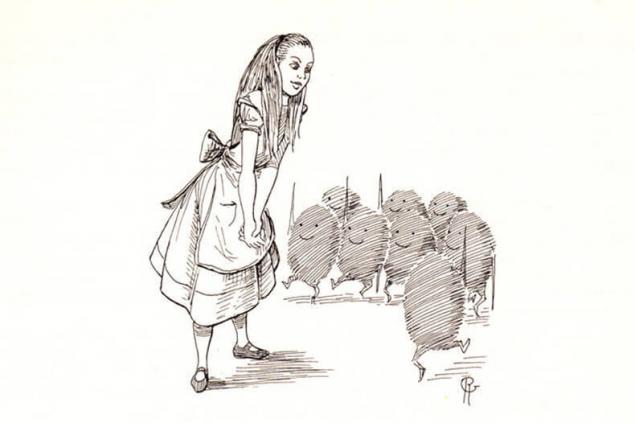
"You know, this is not the way for the Country of photons. We can't control the trajectory of each individual brick — only the probability that he gets at that or another location. This means that when you have only a few bricks, they can be anywhere and it would seem that there is no system at all. But with the increase in their numbers you know that the bricks are only there where there is a likelihood of their occurrence, and the higher the probability, the more bricks there is. When you use a lot of bricks, it all works perfectly".
Energy loan
When Alice went to the door, she found herself in a great hall with columns and marble walls. The inside of the Bank looked like any other. Along the far wall stretched a line of cash boxes, and the space was divided by portable partitions, so that customers had to line up in orderly queues to have them serviced. However, at the moment visitors in the hall was not: except for the tellers and one guard was visible.
As Alice was advised to apply for information to the Bank, she purposefully headed towards the line of Windows. "Wait a minute! cried her guard down. Where are you going, young miss? You don't see that there's a line?"
"Excuse me, — said Alice. But I don't see the queue. There's no one here".
"Of course there is, and a lot of them! — firmly replied the guard. — Looks like we have an influx of "nobody". Although we usually treat them as virtual visitors. I have rarely seen so many virtual particles waiting for their energy loans".
Alice there was the familiar feeling that the situation is unlikely to quickly clear up. She looked at the Windows and saw that, though the room remained empty, the cashiers were very busy. Watching them, she noticed, as the one, then to another window appear bright shapes and quickly race away from the Bank. One of the offices she saw a pair of figures materialized at the same time. In one she learned electron, and the other was similar to its photographic negative, all opposite to those electrons that it has previously seen.
"This is a positron, the antielectron," he whispered in her ear the voice. Alice turned around and saw a well-dressed young woman with a strict look. "Who are you?" — asked the girl.
"I am the Manager of the Bank,' replied her companion. — I am responsible for the results energy loans to all virtual particles. Most of them photons, as you can see, but sometimes they come in pairs of particles and antiparticles".
"Why would they need an energy loan? — Alice asked. And why can't I see them before they get back?"
"You see, — said the Manager — that the particle could exist properly, that is free to move and be observed, it needs a certain minimum energy, which we call the residual energy of the mass. Those poor virtual particles don't even have that amount of energy. Fortunately for them, they can borrow it from us in the Bank, and it allows them to exist for some time". She pointed to hanging on the wall a sign that read:
"The terms of the loan: ΔE x Δt = ħ/2. Prompt payment is appreciated"
"This is called the Heisenberg uncertainty relation, — said the Manager. — It governs all our transactions. The value of ħ is called the Planck constant. This ratio determines the exchange rate for any energy loans. ΔE is the amount of energy that is, and Δt is the period for which issued the loan".
"You mean, — said Alice, trying to keep track of the thoughts of Manager — what is the exchange rate between different types of money, so the bigger the loan term, the more energy they can get?"
"Oh, no! Just the opposite! Multiplied together at each other the energy and time remain constant, so the more energy in the loan, the less time it can be used. If you want to visually see what I mean, just look at these exotic particle and antiparticle, which just took a loan in window No. 7."

Alice looked where the woman pointed, and saw a startling phenomenon. Before the window stood a pair of figures; one was the opposite of the other like electron and positron that she had seen earlier. These two, whatever it was, was a bright, fanciful figures, which occupied so much space that almost completely obscured by the cashier. Alice could not fail to be impressed by the extravagance of the couple, but as soon as she opened her mouth to comment, they were dimmed with mist and disappeared.
"This illustrates my story — calmly continued the Manager. — This pair took a huge energy loan to support a large residual mass that they need for their lifestyle. Because the loan was so large, the repayment period was very short — so that they don't even have time to leave the counter at the cash register before he had to pay. Since such heavy particles can not move very far before they have to repay their energy debt, they are known as korotkoperiodnye particles".
"It turns out, the relationship between time and energy equally for all?" — Alice asked, feeling that she was able to come to some kind of certainty.
"Exactly! Planck constant is always the same, regardless of where and when it applies. In the Bank we are dealing with energy, because energy is the main currency in the Quantum country. How do you Express your currency in pounds and dollars, the unit of energy, which we often use, called eV. The amount of energy, which is owned by the particle, determines what it can do, what assets will go, how much it can affect other systems.
Not all particles need as those who stand here in the queue. Many of them have enough of their own energy, and in this case they can keep it as long as you see fit. Those particles that you might meet on the street. Any part that needs weight, have the energy to exist".
She pointed to another sign on the wall that said: "Mass is energy, energy is mass".
"If a particle wants to have mass, it is necessary to find the energy to maintain it. If beyond that there is still some energy, you can use it for other purposes. But not that all the particles were worried about the masses, she added. There are giddy, Bohemian particles that have no rest mass. Their freedom is not restricted as the majority of the particles, which need to maintain your weight, so that they can benefit even from small amounts of energy. For example, photons. The photon has no rest mass, so a photon at rest doesn't weigh anything at all.
Pay attention, you usually won't find a photon at rest — they are all the time coming and going at the speed of light, because the photons are the light that you see. Light is not a smooth continuous flow, it consists of many quanta, little containers of energy, so that the light flux is not uniform. Now look at these photons leaving the Bank. Basically photons are all the same — just as all electrons are the same. But you may notice that many of them seem very different. This is because they have different amounts of energy."


What is energy
"It's a truly entertaining,' said Alice, not entirely insincerely. But I'm still puzzled by the idea of energy. Could you explain to me what it is?"
"This is a very reasonable question — with satisfaction said the Manager. But, unfortunately, it is not very easy to answer. Let's go to my office, and I'll try to give you an explanation."
The Manager quickly took Alice on the tiled floor of the main hall and through an unobtrusive but rather forbidding the kind of door in one corner. Inside was a large modern office. By putting Alice in a deep comfortable chair, positioned in front of a wide Desk, the Manager walked around and sat on the chair on the other side.
"Energy is like money in your world, and at the same time not easy to explain what it is," began the woman.
"I thought it was just,' replied Alice. — Money is the coins in my pocket, or notes."
"It's cash, which are a form of money, but money does not necessarily exist in the form of banknotes and coins. They can be in a savings account, for example, or in stocks, or invested in the building. Similarly, the energy can take forms which seem to us very different from one another.
"The most obvious form is the kinetic energy", — said the Manager, getting comfortable on her chair, and her voice had a smug tone of the lecturer, speaking with a long story before an audience.
"Particle or any other object for that matter, will have kinetic energy if it is moving. The word "kinetic" means movement. There are other forms of energy. There are potential energy — the energy of gravitation the stone is located on top of a hill and preparing to roll down. There are also electrical and chemical energy — they both represent only the potential energy of the electrons inside the atoms. Also, as I mentioned, there is the energy of the rest mass, which is necessary for many particles to have mass to exist. One form of energy can be converted into another like you can put cash on your Deposit. I can illustrate your explanation, if you look through the round window".

She leaned over and pressed a button on the table and on the wall in front of Alice came round window. Through it Alice could see the rollercoaster. As she watched, the trailer was at the peak of one climb and stopped for a moment before tumbling down the other side.
"As you can see, the trailer is not currently moving, so it has no kinetic energy, but it rose so high that it has potential energy associated with its position. Now when he starts to go down, it will lose height and, consequently, of the potential energy. It will turn into kinetic energy so that on the descent trailer will be up".
Alice could vaguely hear the cheers of the passengers in the van when it rolled down.
"If the journey was very smooth and the wheels moved without friction, the carriage again came to rest at the same height," continued the lecturer. She bent over again and again she fiddled with something on his Desk. Distant figures on the roller coaster cried out in surprise, as a new round suddenly rose in front of them at a much greater height. The truck slowed down and completely stopped before you reach the top.
"How did you do it?" — Alice asked in amazement.
"Never underestimate the influence of the Bank,' murmured her companion. — Now watch what happens."
The trailer began rolling backwards accompanied by even more screams, but not as joyful as last time. He picked up speed, until I slipped lower and then climbed to the next turn, gradually slowing down. He stopped at the peak where Alice first saw it, and then began again to glide back down.published
Author: Daria Varlamova
P. S. And remember, only by changing their consumption — together we change the world! ©
Join us in Facebook , Vkontakte, Odnoklassniki
Source: theoryandpractice.ru/posts/8442-alise-in-quantumland
Published several excerpts from the book about how the probability distribution and why the energy is like money.

Non-random house
...She went to an empty spot near the road where a group of construction workers gathered near a pile of bricks. Alice assumed it was the builders as they unloaded new bricks from a small truck.
"At least these people seem to behave wisely", she thought. Immediately after that, because of the angle ran out the other group, holding something that looked like a very large rolled up carpet, and began to spread it on the site. When the canvas is unrolled to the end, Alice saw that it was something like a construction plan.
It looked like a very great plan because it covers most of the available space. "Why do they do it? I'm sure he's the same size as the building which they intend to build, — mused Alice. — But how can they build anything if the plan already takes up all the space?"

The builders have finished to put the plan into place and returned to the pile of bricks. They picked up the bricks and started throwing them at the plan in a random order. Chaos: something accidentally falling on one place, some to another, and Alice could not understand the concept. "What are you doing? she asked the man who stood on the sidelines. He did nothing, so she assumed it was the Brigadier. — You simply create a messy pile of bricks. Don't you need to build a building?"
"Of course not, dear,' replied the foreman. Really, the random fluctuations are large enough to hide the pattern, but since we put a probability distribution for the result we need, we get there, don't worry".
Alice felt that this expression of optimism did not sound very convincing, but remained in place and watched as the rain of bricks continued to fall on the ground. Gradually, to her amazement, she found that certain parts down more bricks than the others, so she saw stood out schemes of doors and walls. In fascination she watched as recognizable shapes of rooms began to appear from the initial chaos. "That's awesome! she screamed. — How did you manage to do it?"
"Didn't I say? smiled the foreman. — You saw how we put on the ground the probability distribution before you start. It determines where there should be bricks and where they should not be. This must be done prior to laying bricks since we can't predict where will each of us thrown the brick, you know."
"I don't understand why,' interrupted Alice. — I got used to the fact that bricks are put in place one by one, in neat rows".

"You know, this is not the way for the Country of photons. We can't control the trajectory of each individual brick — only the probability that he gets at that or another location. This means that when you have only a few bricks, they can be anywhere and it would seem that there is no system at all. But with the increase in their numbers you know that the bricks are only there where there is a likelihood of their occurrence, and the higher the probability, the more bricks there is. When you use a lot of bricks, it all works perfectly".
Energy loan
When Alice went to the door, she found herself in a great hall with columns and marble walls. The inside of the Bank looked like any other. Along the far wall stretched a line of cash boxes, and the space was divided by portable partitions, so that customers had to line up in orderly queues to have them serviced. However, at the moment visitors in the hall was not: except for the tellers and one guard was visible.
As Alice was advised to apply for information to the Bank, she purposefully headed towards the line of Windows. "Wait a minute! cried her guard down. Where are you going, young miss? You don't see that there's a line?"
"Excuse me, — said Alice. But I don't see the queue. There's no one here".
"Of course there is, and a lot of them! — firmly replied the guard. — Looks like we have an influx of "nobody". Although we usually treat them as virtual visitors. I have rarely seen so many virtual particles waiting for their energy loans".
Alice there was the familiar feeling that the situation is unlikely to quickly clear up. She looked at the Windows and saw that, though the room remained empty, the cashiers were very busy. Watching them, she noticed, as the one, then to another window appear bright shapes and quickly race away from the Bank. One of the offices she saw a pair of figures materialized at the same time. In one she learned electron, and the other was similar to its photographic negative, all opposite to those electrons that it has previously seen.
"This is a positron, the antielectron," he whispered in her ear the voice. Alice turned around and saw a well-dressed young woman with a strict look. "Who are you?" — asked the girl.
"I am the Manager of the Bank,' replied her companion. — I am responsible for the results energy loans to all virtual particles. Most of them photons, as you can see, but sometimes they come in pairs of particles and antiparticles".
"Why would they need an energy loan? — Alice asked. And why can't I see them before they get back?"
"You see, — said the Manager — that the particle could exist properly, that is free to move and be observed, it needs a certain minimum energy, which we call the residual energy of the mass. Those poor virtual particles don't even have that amount of energy. Fortunately for them, they can borrow it from us in the Bank, and it allows them to exist for some time". She pointed to hanging on the wall a sign that read:
"The terms of the loan: ΔE x Δt = ħ/2. Prompt payment is appreciated"
"This is called the Heisenberg uncertainty relation, — said the Manager. — It governs all our transactions. The value of ħ is called the Planck constant. This ratio determines the exchange rate for any energy loans. ΔE is the amount of energy that is, and Δt is the period for which issued the loan".
"You mean, — said Alice, trying to keep track of the thoughts of Manager — what is the exchange rate between different types of money, so the bigger the loan term, the more energy they can get?"
"Oh, no! Just the opposite! Multiplied together at each other the energy and time remain constant, so the more energy in the loan, the less time it can be used. If you want to visually see what I mean, just look at these exotic particle and antiparticle, which just took a loan in window No. 7."

Alice looked where the woman pointed, and saw a startling phenomenon. Before the window stood a pair of figures; one was the opposite of the other like electron and positron that she had seen earlier. These two, whatever it was, was a bright, fanciful figures, which occupied so much space that almost completely obscured by the cashier. Alice could not fail to be impressed by the extravagance of the couple, but as soon as she opened her mouth to comment, they were dimmed with mist and disappeared.
"This illustrates my story — calmly continued the Manager. — This pair took a huge energy loan to support a large residual mass that they need for their lifestyle. Because the loan was so large, the repayment period was very short — so that they don't even have time to leave the counter at the cash register before he had to pay. Since such heavy particles can not move very far before they have to repay their energy debt, they are known as korotkoperiodnye particles".
"It turns out, the relationship between time and energy equally for all?" — Alice asked, feeling that she was able to come to some kind of certainty.
"Exactly! Planck constant is always the same, regardless of where and when it applies. In the Bank we are dealing with energy, because energy is the main currency in the Quantum country. How do you Express your currency in pounds and dollars, the unit of energy, which we often use, called eV. The amount of energy, which is owned by the particle, determines what it can do, what assets will go, how much it can affect other systems.
Not all particles need as those who stand here in the queue. Many of them have enough of their own energy, and in this case they can keep it as long as you see fit. Those particles that you might meet on the street. Any part that needs weight, have the energy to exist".
She pointed to another sign on the wall that said: "Mass is energy, energy is mass".
"If a particle wants to have mass, it is necessary to find the energy to maintain it. If beyond that there is still some energy, you can use it for other purposes. But not that all the particles were worried about the masses, she added. There are giddy, Bohemian particles that have no rest mass. Their freedom is not restricted as the majority of the particles, which need to maintain your weight, so that they can benefit even from small amounts of energy. For example, photons. The photon has no rest mass, so a photon at rest doesn't weigh anything at all.
Pay attention, you usually won't find a photon at rest — they are all the time coming and going at the speed of light, because the photons are the light that you see. Light is not a smooth continuous flow, it consists of many quanta, little containers of energy, so that the light flux is not uniform. Now look at these photons leaving the Bank. Basically photons are all the same — just as all electrons are the same. But you may notice that many of them seem very different. This is because they have different amounts of energy."


What is energy
"It's a truly entertaining,' said Alice, not entirely insincerely. But I'm still puzzled by the idea of energy. Could you explain to me what it is?"
"This is a very reasonable question — with satisfaction said the Manager. But, unfortunately, it is not very easy to answer. Let's go to my office, and I'll try to give you an explanation."
The Manager quickly took Alice on the tiled floor of the main hall and through an unobtrusive but rather forbidding the kind of door in one corner. Inside was a large modern office. By putting Alice in a deep comfortable chair, positioned in front of a wide Desk, the Manager walked around and sat on the chair on the other side.
"Energy is like money in your world, and at the same time not easy to explain what it is," began the woman.
"I thought it was just,' replied Alice. — Money is the coins in my pocket, or notes."
"It's cash, which are a form of money, but money does not necessarily exist in the form of banknotes and coins. They can be in a savings account, for example, or in stocks, or invested in the building. Similarly, the energy can take forms which seem to us very different from one another.
"The most obvious form is the kinetic energy", — said the Manager, getting comfortable on her chair, and her voice had a smug tone of the lecturer, speaking with a long story before an audience.
"Particle or any other object for that matter, will have kinetic energy if it is moving. The word "kinetic" means movement. There are other forms of energy. There are potential energy — the energy of gravitation the stone is located on top of a hill and preparing to roll down. There are also electrical and chemical energy — they both represent only the potential energy of the electrons inside the atoms. Also, as I mentioned, there is the energy of the rest mass, which is necessary for many particles to have mass to exist. One form of energy can be converted into another like you can put cash on your Deposit. I can illustrate your explanation, if you look through the round window".

She leaned over and pressed a button on the table and on the wall in front of Alice came round window. Through it Alice could see the rollercoaster. As she watched, the trailer was at the peak of one climb and stopped for a moment before tumbling down the other side.
"As you can see, the trailer is not currently moving, so it has no kinetic energy, but it rose so high that it has potential energy associated with its position. Now when he starts to go down, it will lose height and, consequently, of the potential energy. It will turn into kinetic energy so that on the descent trailer will be up".
Alice could vaguely hear the cheers of the passengers in the van when it rolled down.
"If the journey was very smooth and the wheels moved without friction, the carriage again came to rest at the same height," continued the lecturer. She bent over again and again she fiddled with something on his Desk. Distant figures on the roller coaster cried out in surprise, as a new round suddenly rose in front of them at a much greater height. The truck slowed down and completely stopped before you reach the top.
"How did you do it?" — Alice asked in amazement.
"Never underestimate the influence of the Bank,' murmured her companion. — Now watch what happens."
The trailer began rolling backwards accompanied by even more screams, but not as joyful as last time. He picked up speed, until I slipped lower and then climbed to the next turn, gradually slowing down. He stopped at the peak where Alice first saw it, and then began again to glide back down.published
Author: Daria Varlamova
P. S. And remember, only by changing their consumption — together we change the world! ©
Join us in Facebook , Vkontakte, Odnoklassniki
Source: theoryandpractice.ru/posts/8442-alise-in-quantumland
50 books that changed literature that everybody should read
Prepare a USEFUL UNLEAVENED homemade bread



